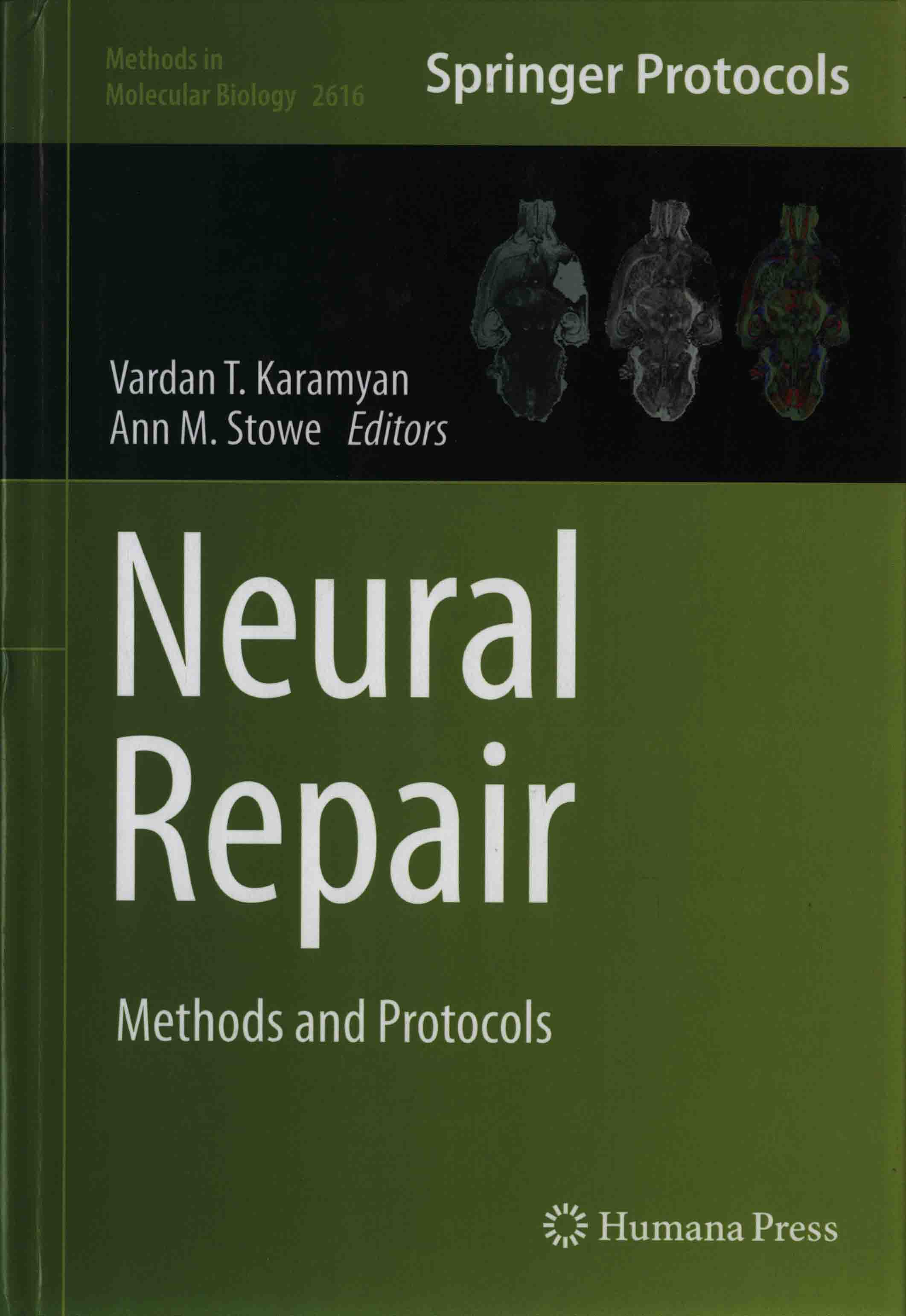 |
Neural repair : methods and protocols / edited by Vardan T. Karamyan, Ann M. Stowe. -- New York, NY : Humana Press, 2023. – (58.17/M592/v.2616) |
Contents
Preface
Contributors
PART I STROKE MODELS AND SURGICAL INTERVENTIONS
1 Rodent Stroke Models to Study Functional Recovery and Neural Repair
2 Subcortical White Matter Stroke in the Mouse: Inducing Injury and Tracking Cellular Proliferation
3 A Low-Budget Photothrombotic Rodent Stroke Model
4 Photothrombotic Model to Create an Infarct in the Hippocampus
5 Bilateral Carotid Artery Stenosis and Cerebral Blood Flow Outcomes
6 Internal Carotid Artery Stenosis: A Surgical Mouse Model to Study Moyamoya Syndrome
7 Modeling Distal Middle Cerebral Artery Occlusion in Neonatal Rodents with Magnetic Nanoparticles or Magnetized Red Blood Cells
PART II IN VIVO AND POST-MORTEM IMAGING OF RECOVERY MECHANISMS
8 In Vivo Imaging of the Structural Plasticity of Cortical Neurons After Stroke
9 Measurement of Uninterrupted Cerebral Blood Flow by Laser Speckle Contrast Imaging (LSCI) During the Mouse Middle Cerebral Artery Occlusion Model by an Inverted LSCI Setup
10 Multi-exposure Speckle Imaging for Quantitative Evaluation of Cortical Blood Flow
11 Wide-Field Optical Imaging in Mouse Models of Ischemic Stroke
12 Post-mortem Magnetic Resonance Imaging of Degenerating and Reorganizing White Matter in Post-stroke Rodent Brain
PART III METHODS TO IDENTIFY MOLECULAR AND IMMUNE MECHANISMS SUPPORTING RECOVERY
13 Quantitative Spatial Mapping of Axons Across Cortical Regions to Assess Axonal Sprouting After Stroke
14 Quantitative Evaluation of Cerebral Microhemorrhages in the Mouse Brain
15 In Vivo Evaluation of BBB Integrity in the Post-stroke Brain
16 High-Resolution RNA Sequencing from PFA-Fixed Microscopy Sections
17 FACS to Identify Immune Subsets in Mouse Brain and Spleen
18 A Guide on Analyzing Flow Cytometry Data Using Clustering Methods and Nonlinear Dimensionality Reduction (tSNE or UMAP)
19 Co-culturing Immune Cells and Mouse-Derived Mixed Cortical Cultures with Oxygen-Glucose Deprivation to In Vitro Simulate Neuroinflammatory Interactions After Stroke
PART IV BEHAVIORAL METHODS FOR QUANTIFYING FUNCTIONAL RECOVERY
20 Assessing Depression and Cognitive Impairment Following Stroke and Neurotrauma: Behavioral Methods for Quantifying Impairment and Functional Recovery
21 Use of an Automated Mouse Touchscreen Platform for Quantification of Cognitive Deficits After Central Nervous System Injury
22 Using Operant Reach Chambers to Assess Mouse Skilled Forelimb Use After Stroke
23 The Finer Aspects of Grid-Walking and Cylinder Tests for Experimental Stroke Recovery Studies in Mice
24 Performing Enriched Environment Studies to Improve Functional Recovery
PART V NEUROTHERAPEUTICS AND FUNCTIONAL RECOVERY
25 Clinically Applicable Experimental Design and Considerations for Stroke Recovery Preclinical Studies
26 Hydrogels and Nanoscaffolds for Long-Term Intraparenchymal Therapeutic Delivery After Stroke
27 Reverse Translation to Develop Post-stroke Therapeutic Interventions during Mechanical Thrombectomy: Lessons from the BACTRAC Trial
28 Methods to Study Drug Uptake at the Blood-Brain Barrier Following Experimental Ischemic Stroke: In Vitro and In Vivo Approaches
29 Gene Silencing in the Brain with siRNA to Promote Long-Term Post-Stroke Recovery
PART VI MODELS OF COMORBIDITIES
30 Diabetic Rodent Models for Chronic Stroke Studies
31 Use of Conventional Cigarette Smoking and E-Cigarette Vaping for Experimental Stroke Studies in Mice
32 Middle Cerebral Artery Occlusion in Aged Animal Model
33 Acute Ischemic Stroke by Middle Cerebral Artery Occlusion in Rat Models of Diabetes: Importance of Pre-op and Post-op Care, Severity of Hyperglycemia, and Sex
34 The DOCA-Salt Model of Hypertension for Studies of Cerebrovascular Function, Stroke, and Brain Health
Index